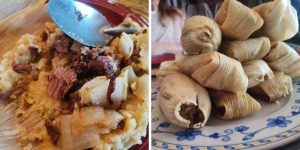From Marjory Wildcraft’s GrowNetwork
Is Buying a Dehydrator Worth the Cost?
Buying a dehydrator can be an investment, although they do come in several different sizes. The smallest dehydrators are typically the cheapest. Often times, the only difference between a “big” dehydrator and a “small” dehydrator is the number of stacking trays that are included – and some brands are modular, so that you can buy more stacking trays as you need them.
Sure a dehydrator is used to dry food, but what about using an oven? And what kinds of things can you dry exactly? While you can dry food on a silicone non-stick baking mat (or parchment paper) at the lowest temperature in an oven, usually around 170F, it takes a long time for the food to dry and there is often a risk of burning. That’s because the function of an oven is to bake, broil and roast food, not to dry it. In comparison, a dehydrator comes equipped with a fan for ventilation and has a temperature range of 95F to 160F. It uses very little electricity and makes about the same amount of noise as a stove. As for what kinds of uses a dehydrator can have, check out the following ideas and recipes. It may just be worth your while to own one if you fancy making these tasty dehydrated treats.
Dried Herbs & Wild Edibles
Growing your own herbs just makes sense: they’re cheap and easy; they make your garden look beautiful and attract pollinators to the garden; and most importantly they enrich your body with local, organic, and sustainable goodness. Leaves such as rosemary, parsley, and oregano; seeds such as celery, dill, and coriander; edible flowers like rose, chamomile, and calendula; and medicinal herbs like lemon balm, feverfew, and mint – all can be easily dried on mesh or solid sheets in your dehydrator.
While you can dry at the lowest recommended setting of 95F, you can also let them air dry before storing them in paper bags or glass containers. If you happen to be growing a lot of herbs, a larger model of dehydrator will come in mighty handy, especially if you also enjoy foraging for wild edibles and wildcrafting with medicinal herbs. Dandelions, violets, plantains, and yarrow come lilting and dancing in spritely spring; wood sorrels, sow thistles, mallows and day lilies beckon forth enticingly in the passionate euphoria of summer; while dandy burdock roots, plantain seeds, rose hips and elderberries lie still waiting in the cool cornucopia of fall. All of these, and so many others, can be made useful by being dried on the many stacked trays of your trusty dehydrator, whatever the season! Drying red clover blossoms is a really great example of how handy a dehydrator can be: since each flower shouldn’t to touch another, a dehydrator with multiple trays is an excellent way to dry a bunch at once, instead of having them spread out all over your kitchen table. Indeed, instead of spreading things out on your table and having your kitchen look a little bit more homely than usual, a dehydrator keeps things looking nice and tidy!
If you want to get started right away, but you don’t own a dehydrator yet – check out this simple trick to dry your herbs with nothing other than a mesh bag: Drying Herbs the Easy Way
Fruit Leathers
You know those fruit leathers, or “roll ups” they sell at the supermarket? They are simply fruits that have been pureed and then dried. You can DIY for cheap, they are easy-peasy to make and oh-so healthy. How to? Blend fresh fruits in a blender to a puree and spread to 1/4 inch thick on a solid sheet. Dehydrate ’til dry, flip the other side, peel off the solid sheet, then continue drying until completely dry. That’s it. You can use just one fruit, like only raspberries, only blueberries, only apples; or do a mix of fruit, such as apples and berries together. Any combination will do, they all pretty much tasty. You can also mix veggies and fruits together, like half carrots and half apples, or half carrots and half peaches.
The bonus is that you can make your own flavors that aren’t sold in stores, like kiwi, plum and strawberry-beet. Don’t care for the seeds? Simply use a food mill after pureeing, then spread thinly on a solid sheet. Not sweet enough? Add in a bit of stevia and dehydrate away! Not only do fruit leathers make healthy snacks, but they make great trail food too. And did I mention that making fruit leathers is a great way to use up fruits and veggies that are starting to rot? Or that your favorite green smoothie can be turned into a fruit leather? While there are plenty of recipes out there, here’s an easy one to get you inspired right away:
Berry Green Fruit Leather Recipe
• 2 cups berries (any kind)
• 1 cup peeled and chopped beets
• 1-2 handfuls chopped greens (e.g. kale, spinach, lettuce, etc.)
• Stevia, to sweeten
• 1/2 cup water, for consistency
Instructions: Puree berries, beets, and greens with enough water to make a smooth puree. Add in stevia to sweeten. Pour onto solid sheets and use a spoon or spatula to spread evenly to 1/4 inch thick. Dehydrate at 115F until dry. Flip, carefully peel away solid sheets and continue drying on mesh sheets, about 6-8 hours total. Using clean scissors, cut fruit leather into long strips or squares.
Notes: 1) You can use 1 cup leftover cooked beets instead. 2) You can pass the puree through a food mill first to remove any seeds, then pour and spread onto solid sheets. 3) Note that the type of green used and how much will affect the taste. 4) You can use 1-2 cups steamed or cooked greens instead. 5) Feel free to double or triple this recipe!
Variation: Apple ‘n’ Cinnamon Fruit Leather: Replace berries with 4-5 peeled, cored and chopped apples. Puree with the rest of the ingredients and add in 1-2 tsp cinnamon to taste. Add in 1-2 bananas for extra sweetness, if desired.
Dried Fruit, Fruit Powders & Chips
If you’re growing your own fruit trees, then besides making jellies, jams and fruit leathers, drying your own fruits is an excellent way to preserve them. Simply slice the fruit 1/8 – 1/4 inch thick and place on mesh sheets to dry. How long it will take for the fruit to dry will depend on moisture content of the fruit and humidity in the air. Once dried, wait 20-30 minutes and evaluate their crispness: can you break them in half? If yes, you can then store the dried pieces in vacuum sealed bags or in glass containers with tight fitting lids. If you are worried about mold, however, you can go one step further and fill a mason jar 3/4 of the way with the dried fruit. Put on the lid and shake twice a day for one week. If you see any condensation, the fruit isn’t dry enough and you should put it back in the dehydrator to dry for longer. If there isn’t any condensation, then you can keep the fruit in the mason jar or store it any way you like.
Interested in growing your own fruit trees? Check out these helpful articles:Create an Inexpensive Orchard with Bare Root Fruit Trees and Prune Your Fruit Trees Now for a Great Harvest Later
Sometimes these dried fruit slices are called chips, and they fetch a high price in health food stores. DIY couldn’t be easier. Sprinkle on your fave spices and sweeteners – for instance, rub apple slices in lemon juice and cinnamon, or top strawberry slices with powdered stevia. You can even dip blueberries in melted chocolate before drying them! In fact, making your own is not only cheaper, it also means you can make fruit chips that you can’t find in stores, like carambola and prickly pear.

Dehydrated apple chips
After your fruit is dried, you can use a high speed blender to grind it into a powder, and you will have made your own smoothie powder! You can use 1/2 – 1 tsp arrowroot powder to help with clumping, if you like. The fruit powder you make can be added to smoothies, sprinkled over porridge and cereal; reconstituted with juice to make popsicles; whisked with vinegar and oil to make fruity salad dressings; added to baked goods like cookies, muffins, waffles, and pancakes; and used to add flavoring to meringues, yogurt, and sorbets.
Here are 2 fun recipes using powdered strawberries for you to try:
Simple Strawberry Dressing Recipe
• 3 TBsp olive oil
• 1 TBsp apple cider vinegar (or your fave herbal vinegar)
• 1 tsp strawberry powder
• Stevia to sweeten
Instructions: Blend all ingredients together, adding additional strawberry powder for flavor, and additional stevia for sweetness, if desired. Feel free to add as much strawberry powder as you like.
Simple Strawberry Popsicles Recipe
• 1/2 cup apple juice
• 3-4 TBsp hot water
• 2 tsp or more strawberry powder
• Stevia to sweeten
Instructions: In a bowl, dissolve the strawberry powder in the hot water. Stir in the apple juice and sweeten with stevia. You can add in more powder, dissolved with hot water, for a stronger taste. Pour into popsicle molds and freeze. Enjoy!
Veggie Leathers as “Bread”
Instead of going the carb (e.g. grain) or fat (e.g. flax or chia) route to make breads, buns, and wraps; why not make “bread” using just veggies? Veggie leathers have the same texture as fruit leathers and you can add tomatoes, sundried tomatoes, herbs like Italian seasoning, and spices like curry to make them taste savory. The secret to making veggie leathers? Psyllium husk! Psyllium husk has a mucilaginous quality that acts as a binder to keep the veggie puree sticking together and then drying into a nice leather. You can also use ground chia or flax seed instead, and, if you want your leather to have more texture, you can always up the amount of flax or chia, or add in other seeds and nuts. Think of the possibilities: carrot leather, beet leather, or a red cabbage and chard “bread”! No more worrying about going for another slice of bread, plus you’ll be sure to be getting in your RDA of veggies! Here’s a recipe to help you out with this idea, using psyllium as a binder:
Carrot Leather “Bread” Recipe
• 5 lbs carrots, peeled, chopped & cooked
• 1 1/2 – 2 TBsp psyllium husk powder
Instructions: After cooking or steaming carrots until tender, puree carrots with just enough water for consistency in a high speed blender. Add in the psyllium and whip to blend. Spread onto 2 solid sheets to 1/4 inch thick, ensuring the batter is uniform. Dehydrate at 115F until dry. Flip the sheets over and peel off the solid sheets. Continue drying on mesh sheets until dry. Using clean scissors, cut each leather into 9 medium or 6 large squares. Use as buns for burgers or as sandwich “bread.”
Variation: You can also puree the carrots in a food processor, transfer to a bowl and add in psyllium husk flakes. Add in 4-6 TBsp, let sit 5 minutes to gel, then spread onto solid sheets.
Variation: Don’t care for the leathery texture? Instead of using the psyllium, do this: soak 1 cup flax seed in 2 cups water for 4-8 hours. Puree the flax seed with 1 cup additional water in a high speed blender ’til smooth. Puree the carrots in a food processor, then add them to the blender with the flax puree and blend ’til smooth. Spread onto solid sheets to 1/4 inch thick, then dry. You can also use 1 cup ground flax seed instead of the soaked whole flax.
If you like this, there are some other ways to substitute vegetables for bread in my article, 8 Ways to Replace Carbs with Home Grown Veggies.
Dried Veggies, Veggie Flours & Chips
Just as with fruit, slicing veggies thinly (or dicing them small) and then dehydrating them on mesh sheets is a great way to preserve them for future use. As with fruit, let cool for 30 minutes before snapping a piece in half to check for dryness, then store in vacuum sealed bags or in glass containers with tightly fitting lids. Nothing could be easier than to rehydrate these dried veggies by adding them to the soup or stew pot!
Again, as with dried fruit, you can grind these dried veggies into a powder and add them to smoothies, baked goods and pasta sauce (e.g. tomato powder) for extra nutrition. Indeed, some folks have gotten the idea to use veggie powders as flour, and you can purchase parsnip, beet and carrot flours for a pretty penny. Is it cheaper to DIY? Absolutely!
It’s cheaper to make your own veggie chips too. Just like those root veggie chips sold in health food stores, which are oh-so tasty, but liberally baked in oil and salt. While there are recipes to make root veggie chips on the lowest setting in your oven, they seem more baked than dried and there’s always that risk of burning. It’s much easier to use that good ol’ dehydrator, and there’s no need for oil at all!
Instructions: Slice root veggies such as carrots, beets, parsnips, turnips, rutabagas and squash very thinly (3/16 of an inch thick) using a mandoline or peeler, place on mesh sheets and dehydrate away! If you like, you can marinate the slices in your fave marinade overnight or toss the slices with some lemon or lime juice and some herbs or spices to taste before drying. Be sure to fill up all the sheets you have, because once these chips are ready, they’re gone!
Here’s a sweet recipe using zucchini and cinnamon:
Simple Cinnamon Zucchini Chips Recipe
• 4-6 large zucchini
• Cinnamon
• Powdered stevia or a stevia blend
Instructions: Peel the zucchini if you like, then use a mandoline to slice zucchini thinly crosswise. Place slices on a mesh tray and sprinkle stevia and cinnamon on top. If you’d like, you can brush the slices with water or a bit of lemon juice to help the powders to stick. Dry at 115F for several hours and devour! Note that you can apply cinnamon and stevia to both sides of the chips, if you like.
Variation: To make these chips savory, you can brush both sides with a thin layer of
• pasta sauce, then sprinkle on Italian seasoning
• BBQ sauce, then sprinkle on cumin and smoked paprika
• lemon juice, then sprinkle on ground dill leaf (ground parsley or coriander leaf are nice too)
• lime juice or water, then sprinkle on rosemary and thyme
Speaking of zucchini, if you ever find yourself with a surplus of zucchini or squash, check out my article 12 Ways to Make a Zucchini Surplus Disappear for some more good ideas.
Believe it or not, these 5 recipes are just the beginning of the great uses I’ve found for my dehydrator. I’m working on another list of 5 more easy dehydrator recipes, and I’ll share it with you soon.





